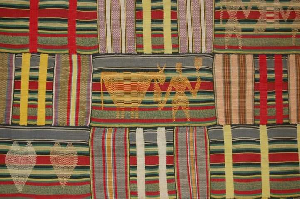This is an EWE KETE (KENTE) made from cotton yarns from 1920 on display in the British Museum.
I would want us to have an intellectual discussion as to why the ORIGIN of the popular KENTE fabric, which is called in the Ewe Language as “KETE”, should be associated more with the Ewe People from #Agortime_Kpetoe than #Bonwire in the Asante land.
I have been unable to find the meaning of the word KENTE, to have any correlation or connection with the process of weaving or the fabric is question in general.
But then the word KETE which is the Ewe synonym for KENTE, has a direct meaning with how the Fabric in question is woven.
“KE” means to “OPEN” and “TE” means to “PRESS TIGHT”. And that is exactly how the fabric is woven by OPENING the “Warp”(lengthwise strings of yarns) and passing the “Shuttle”(wooden bobbin case) carrying the “Weft”(interlacing yarn) through it and then PRESSING IT TIGHT using the “Beater” or “Reed” and then repeating the process over and over.

So we can all generally agree without prejudice that KETE which is the Ewe language of how the woven fabric is called, has a lot of significance to the cloth than the word “KENTE” which has no significant meaning to the Akans or Asantes.

I stand to be corrected though since I am not an Asante. But my research proves it has no direct meaning like the Ewe version.
And then the picture below is a 1920 fabric woven by the Ewe people in the Volta Region. Carefully examine how the Ewe people were able to draw in the fabrics like the Ancient Egyptians. This fabric could even be from the 1800s since the British found it in 1920.
But then the Asantes on the other hand never had any Kente fabrics with motifs or symbolism in it. It was just patterns and trust me that they would have woven a lot of Adinkra symbols in their Ancient Kente like they doing with modern technology, if they had the skills then.

But then the Ancient Ewe Master weavers knew how to weave motifs, symbols and Art in their “KETE” Fabrics and the evidence is in the British Musuem in London for all to see.
And then What I want is for us to critically listen to and compare the stories about the Origin of Kete or Kente as narrated by the people of Agortime-Kpetoe, which is the home of Kete in the Volta Region to the narrative by the People of Bonwire in the Ashanti region which is purported to be where Kente originated.
This I would find time to travel and spend a few days in Bonwire to travel the stories and then spend a few days in Agortime-Kpetoe so that we can compare the facts to further explain why it is important to give due credits in this matter of historical facts.
And then AGBOZUME also has a Kete weaving culture. They call it “AGBATSIMEVOR” which means “Loom made cloth or Fabric”. The people of Agortime_Kpetoe also call “Kete” as “AGBAMEVOR” which also means the same “Loom made cloth”!
“AGBATSI” refers to the Traditional four upright wooden post Loom used in weaving the fabric, “ME” means “Inside” and “VOR” means “Cloth of Fabric”.
And the people of Agbozume had never had an encounter with the Asantes but then have been weaving their unique kind of Kete for centuries.
Been looking to fully investigate the origin of the Loom Weaving culture in Agbozume with time.
#Akpenami
#EweKete
#Kete_Kente
Note: Let’s make this an intellectual argument and not an opportunity to disrespect our various tribes. The story needs to be told.
📸 khanacademy.org
✍️ Selorm Ameza
Source: Queen Xorlali
 Home Of Ghana News Ghana News, Entertainment And More
Home Of Ghana News Ghana News, Entertainment And More




